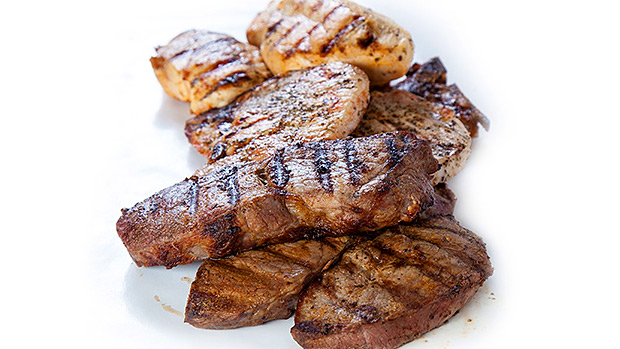As long as I can remember, people in the fitness biz have believed that you could only absorb 30 grams of protein in one sitting. No one ever bothered to explain what would happen if you ate 31 grams, but the thinking must be that the small intestine would act like a power forward in the NBA and reject that shit, its thousands of villi shaking like so many fingers to say, "Not in our house."
This 30-gram barrier was considered an immutable fact, and no one knows for sure where it originated, but we can safely say that it's totally wrong.
The truth is, the only limits to the amount of protein you can absorb in one sitting is the size of your stomach.
Things start to make a little more sense when you start examining the different ways your body uses protein. If you ingest 30 grams of protein after a workout, it'll increase muscle protein synthesis by about 50%, but that's where it gets stuck.
You could triple your protein intake to 90 grams in that one sitting, but it wouldn't do much of anything to increase muscle protein synthesis (1). That might not be true for steroid users, but we're talking about people who have a neck.
That's not proof that the 30-gram-per-sitting people were right. They're forgetting that protein is needed for a whole lot of other stuff, too, and the body gives priority to that other stuff.
Protein, as you know, is an essential nutrient. It's broken down into amino acids and the body can't get them from fat or carbs, no matter how tasty they are. These amino acids are used to make hormones, enzymes, immune factors, and other non-muscle tissues. Once the protein requirements for all that stuff is met, the body can use the surplus to increase muscle protein synthesis.
In other words, you can't rob Peter's hormone and enzyme requirements to pay Paul's muscle protein synthesis wants. In APCO police code, that would qualify as a 10-65, or Armed Robbery – not be confused with a 10-68, which is Livestock in Roadway.
Given the information above, it makes sense for most lifters to take in about 40 grams of protein in one sitting. This would be enough to fulfill the hormone, enzyme, immune factor, and non-muscle tissue requirements, in addition to providing enough protein to maximize muscle protein synthesis.
Of course, human beings vary enormously in size, activity levels, age, and hormone levels, but the 40 grams per serving number is a good number for most people, most of the time. In fact, T Nation contributors Brad Schoenfeld and Alan Aragon came up with similar recommendations in their landmark study of the topic (2).

That brings us to the next logical question: What happens to any protein intake beyond 40 grams? Quite simply, it gets turned into glucose and is either used for energy or stored as fat. However, there are good reasons where you would want to use protein as a source of energy over carbs or fat:
- Protein keeps you full longer, thus putting the kibosh on the urge to eat surplus calories.
- Protein has the largest TEF (Thermic Effect of Food) of the three nutrients (fat, carbohydrate, and protein). If you eat an amount of protein that has 100 calories, it takes roughly 10 of those calories to process the protein.
- Protein has a minimal effect on blood sugar levels, so there's no surge of insulin.
So, for purely muscle building purposes, take in about 40 grams per serving. For body composition purposes (maximum amount of muscle, minimum amount of fat), take in more than 40 grams per sitting, up to 35 to 40% of total calories.
While you can do this by eating large amounts of whole-food protein sources several times a day, it's fairly difficult to do without the aid the aid of a quality protein powder.
- Symons TB et al. A moderate serving of high-quality protein maximally stimulates skeletal muscle protein synthesis in young and elderly subjects. J Am Diet Assoc. 2009 Sep;109(9):1582-6. PubMed.
- Schoenfeld BJ et al. How much protein can the body use in a single meal for muscle-building? Implications for daily protein distribution. J Int Soc Sports Nutr. 2018 Feb 27;15:10. PubMed.





